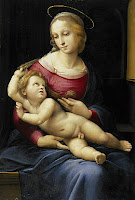Fugue portraiture without chronology and temporal contraints
 The Virgin and Child ('The Bridgewater Madonna') Taken from: http://www.nationalgalleries.org/index.php/collection/online_az/4:322/results/0/8675/
The Virgin and Child ('The Bridgewater Madonna') Taken from: http://www.nationalgalleries.org/index.php/collection/online_az/4:322/results/0/8675/Bach would have wanted more than the simple methods we use today to communicate and later argue minor issues and trivial details. We know the body of knowledge that we are working with today. Whatever we are to know is apart form the continum that we use for researching the world and ourSELF. We have a collective limitation, but slowly we advance what we all know and share. Sometimes patterns and similarities occur that jump beyond the collective limitations of our knowledge and we have something made new.
I am struggling here to pattern something. I am at a loss as to how to show something of Raphael through the blog and have or convey the magesty of his portraiture. It is completely incongruous to refer to J.S. Bach as something of an example, these figures were not contemporaries. Raphael lived during the High Rennaisance from 1483-1520. His music was quite different. Bach was living in a much more tumultuous time for social orders and induvidualities.
Chronology: http://www2.nau.edu/~tas3/chroncontemps.html
Dispite this weak argument for a connection, I am unable to separate the two. Raphael sounds to me like J.S. Bach.
Perhaps it is the method or specifically the contrapposto. Both masters use tension and receeding black (foil or a compression of space) that might suggest a landscape or a simple inky source or frame for what we have presented directly and generously and directly toward us as viewers/listeners.
This essay: "Intentionality and Meaningfulness in Bach's Cyclical Works" is more that I am interested in exploring in the above musing. (http://www2.nau.edu/~tas3/intentional.html)
There is a quote:
A personal search for knowledge involves the search for patterns within patterns in a holistic context. No pattern can occur in isolation, autonomous from a larger context or set of assumptions, and still be meaningful to human beings. Patterns require larger contexts, with relevance to more inclusive patterns, if they are themselves to be meaningful to us. The total autonomy of parts of knowledge does not exist. Conviction 5.1: A description of units within patterns within larger intersecting patterns is a kind of knowledge and a component of truth.
Kenneth L. Pike from "Talk, Thought, and Thing: the emic road toward conscious knowledge" (Dallas: Summer Institute of Linguistics, 1993) p. 55
Kenneth L. Pike from "Talk, Thought, and Thing: the emic road toward conscious knowledge" (Dallas: Summer Institute of Linguistics, 1993) p. 55
All of this requires more attention and thought.
FC

Comments
http://www.northwestern.edu/magazine/northwestern/summer2001/features/crossingborders/index.htm
http://www.newsroom.ucr.edu/cgi-bin/display.cgi?id=1391